
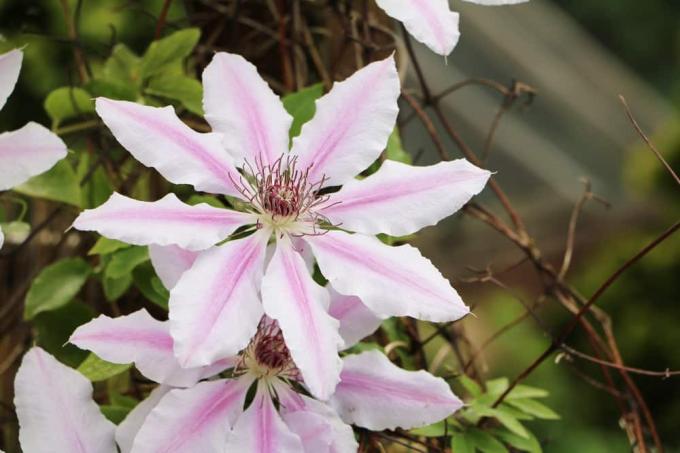
Table of contents
- Good reasons for a pruning
- Pruning group I - early varieties
- cutting guide
- Pruning group III - late varieties
- cutting guide
- Build-up cut independent of the cut group
- A few tips at the end
The clematis from the buttercup family grows as a herbaceous climber, shrub or semi-shrub as well as medium- or strong-growing lianas, but above all woody. It is divided into different groups, which differ in growth vigor and flowering time, with the early flowering ones being particularly vigorous. Clematis hybrids, on the other hand, produce the largest flowers. The most important part of care is pruning.
Good reasons for a pruning
There are many good reasons for regular trimming of clematis as it brings some significant benefits to this attractive and versatile plant. So every cut has its justification, provided it is done at the best time and in the right way.
- Thinning cut, provides more light inside the plant
- Shoots inside the plant can develop optimally and branch out better
- Affects both existing and newly forming shoots
- This cut, especially recommended for early flowering varieties
- Regular removal of old shoots results in the formation of new ones
- This form of pruning is recommended for all Clematis varieties
- Rejuvenation pruning serves to rejuvenate plants that have been neglected for a long time
- For rejuvenation, a radical pruning is required about every four to five years
- This cut, advisable on old and already bare plants of all varieties
The removal of withered flowers makes sense, especially in the case of clematis that bloom more often, because this cut is usually followed by a second, even more intensive bloom. When and how exactly a clematis should be pruned depends to a large extent on the flowering period. This is exactly what divides the plant into different cutting groups.
Pruning group I - early varieties

Pruning group I includes varieties that bloom in spring. Some show their magnificent flowers as early as April, but most in May. The buds of these clematis are formed in autumn on the previous year's shoots or laid out so that they are already in full bloom in spring. For this reason, cutting back in autumn would not make sense, because then you would cut off all the fresh buds and there would be no flowering. Pruning group I clematis includes robust and vigorous wild species such as B. the alpine clematis (C. Alpina) and the anemone clematis (C. Montana) that don't need more pruning. However, an occasional clearing cut is still useful.
cutting guide
As already mentioned, with a pruning group I clematis it is sufficient to just thin it out or shorten it every year if it has become too large. The best time to do this is around June/July after flowering. This allows the plants to form new flowering shoots in peace until the next season.
- After flowering, cut out everything that is wilted, dead and dead
- In addition, remove any seed heads that form
- They unnecessarily deprive the plant of energy
- Also shorten side shoots that are too long
- This is how the clematis can be brought back into shape
- Rejuvenate old and already bare clematis in this pruning group
- Rejuvenation pruning is also recommended here every four to five years
- The best time for this cut is late autumn or late autumn. November December
You can even perch the plant by topping it about four to six inches off the ground. After such a pruning, the plant initially uses all its energy in the formation of new shoots and neglects the formation of flowers, so that one has to do without flowers for a year. The taper cut is best done in two steps. In the first, half of the shoots are cut back to just above the ground. In the second step or then the next year do the other half in the same way.
Pruning group III - late varieties
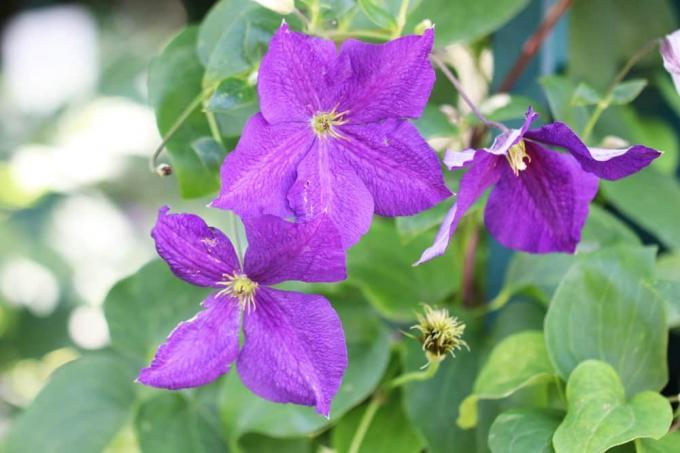
If the clematis only blooms in the second half of June and in July, it belongs to pruning group III, because it includes all late-blooming or most summer-blooming varieties. They have the property of sprout strongly every year and shoot up, which usually requires a stronger pruning.
Without pruning, they can easily grow up to 500 cm in height. In contrast to the other pruning groups, the new shoots are not formed on the old wood, but directly from the roots. This pruning group includes our native clematis (C. Vitalba), all once flowering hybrids (C. Jackmannii) and the large group of perennial clematis.
cutting guide
- The best time for pruning is late autumn, around November/December
- If the right time is missed, pruning is also possible in early spring
- Preferably pick up the scissors between February and March
- The shoots of these varieties are formed from the roots
- As a result, a radical pruning is also possible without any problems
- Cut the clematis back to 20-50 cm above the ground
- At the same time, cut off dead, dry and diseased wood directly at the base
- When cutting in spring, watch out for the new shoots
- New shoots could accidentally be cut with the cut
Tip:
If you do without such radical cuts with these varieties, these plants can grow old relatively quickly. Then it takes a lot more time and work to bring them back to their former glory.
Build-up cut independent of the cut group
A so-called build-up pruning in the year of planting is recommended for all varieties, regardless of when they bloom or which pruning group they belong to. With this cut, the clematis should be raised into a well-branched plant. It then drives out stronger and more densely branched the following year. The formation of bald spots is counteracted. The build-up cut can be made in November/December, just like the normal pruning. All shoots or Tendrils back to a height of 20 or 30 centimeters. However, some hybrids and wild species have to do without flowering in spring the next year. But later they bloom all the more beautifully and lushly.
A few tips at the end
Regular pruning is almost always recommended for this plant, even if you limit it to the bare essentials with the early-flowering varieties. Be it to make them regrow more compact, dense and better branched, to limit their height or to bring older, not so beautiful specimens back to life. However, before you reach for the scissors, you should make sure what kind of variety or group of cuts it is, or what type of cut it is. when it blooms.

Both the time of the cut and the procedure for the cut depend on this. In general, summer-flowering varieties require a more vigorous pruning, while wild varieties and large-flowered hybrids should be blended more cautiously. Incidentally, the clematis flowers regardless of the cut, only from the third year of growth, because then it is, so to speak, mature.
 garden editorial
garden editorial I write about everything that interests me in my garden.
Learn more about clematis
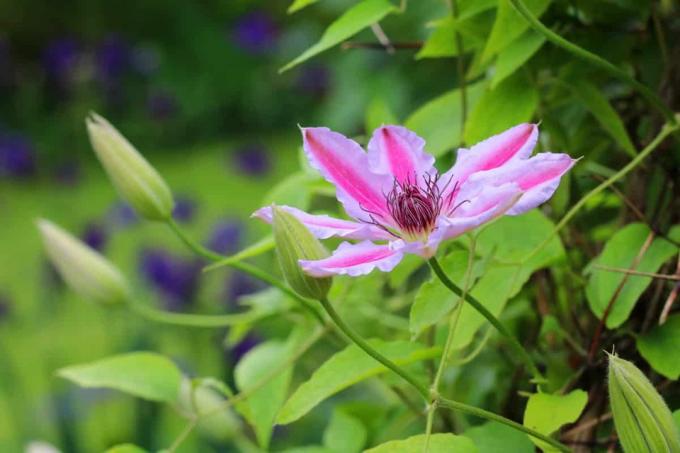
Lice, beetles & co: common clematis pests
Above and below ground there are many pests that can pose a threat to clematis. Without suitable countermeasures, some pests can damage a magnificent perennial so much within a few days that it dies.

Clematis gets brown leaves - combat clematis wilt
Clematis wilt is a menacing disease that occasionally afflicts clematis. Especially the popular, large-flowered hybrids are being swept away at high speed. Left to its own devices, the clematis is helplessly at the mercy of the fungal pathogen. However, with the help of her owner, she is able to survive.
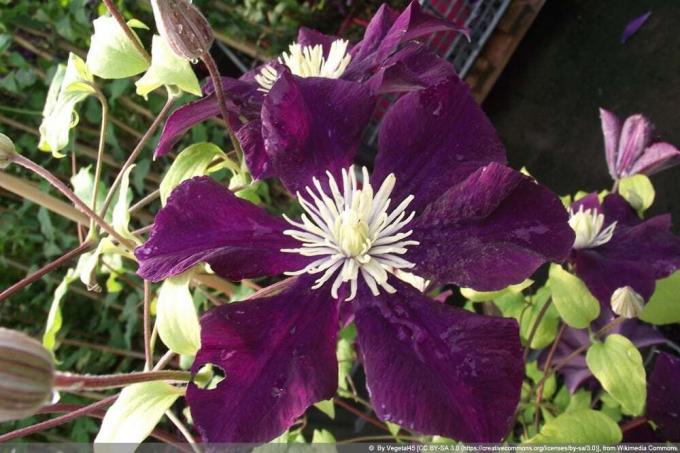
Clematis 'Warszawska Nike' Warsaw Night - care and pruning
The Clematis 'Warszawska Nike' Warsaw Night scores with its flowers. With the easy-care climbing plant you definitely get an eye-catcher in the garden. Only the cut is a bit difficult and requires courageous access. More about this is here.
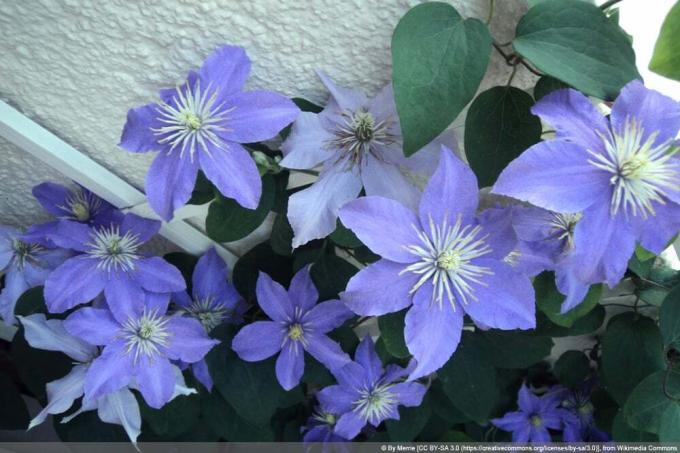
Clematis 'Justa' clematis - profile, care and cutting
Clematis 'Justa' clematis is a dwarf variety that has strong growth. In the summertime, the plant adorns itself with beautiful purple flowers that can also shine light blue. The clematis grows climbing and can reach a considerable height.

Clematis 'Nelly Moser' - pruning and care from A-Z
The clematis 'Nelly Moser' inspires with delicate pink flowers. A strong violet central stripe on each petal and the red stamens add harmonious color accents. In May and June, it unleashes a veritable explosion of flowers. With proper care, it also gives away a second bloom.

Clematis 'Piilu' clematis - profile, care and cutting
Clematis 'Piilu' is a particularly attractive and floriferous representative of the clematis. Its large, plate-shaped flowers captivate with an extraordinary color brilliance in dreamlike pink to violet and a second bloom until September.
